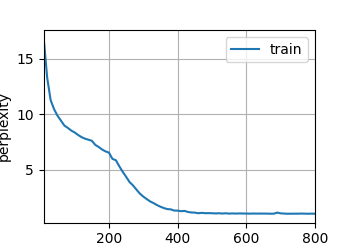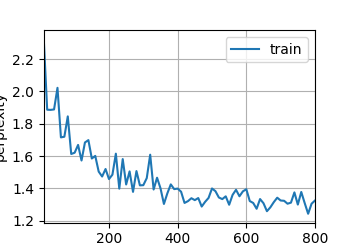import math
import torch
from torch import nn
from torch.nn import functional as F
from d2l import torch as d2l
batch_size, num_steps = 32, 35
train_iter, vocab = d2l.load_data_time_machine(batch_size, num_steps)
X = torch.arange(10).reshape((2, 5))
print(X)
print(F.one_hot(X.T, 28).shape)
# 初始化循环神经网络模型参数
def get_params(vocab_size, num_hiddens, device):
num_inputs = num_outputs = vocab_size
def normal(shape):
return torch.randn(size=shape, device=device) * 0.01
# 隐藏层参数
W_xh = normal((num_inputs, num_hiddens))
W_hh = normal((num_hiddens, num_hiddens))
b_h = torch.zeros(num_hiddens, device=device)
# 输出层参数
W_hq = normal((num_hiddens, num_outputs))
b_q = torch.zeros(num_outputs, device=device)
# 附加梯度
params = [W_xh, W_hh, b_h, W_hq, b_q]
for param in params:
param.requires_grad_(True)
return params
# 初始化隐藏状态
def init_rnn_state(batch_size, num_hiddens, device):
return (torch.zeros((batch_size, num_hiddens), device=device),)
# 定义如何再一个时间步内计算隐藏状态和输出
def rnn(inputs, state, params):
"""
实现一个简单的RNN层。
参数:
- inputs: 输入序列的张量,形状为(时间步数,批量大小,词表大小)。
- state: RNN的初始状态,是一个张量,形状为(批量大小,隐藏层大小)。
- params: 包含所有需要的参数的元组,其中:
- W_xh: 从输入到隐藏层的权重矩阵。
- W_hh: 从隐藏层到隐藏层的权重矩阵。
- b_h: 隐藏层的偏置项。
- W_hq: 从隐藏层到输出的权重矩阵。
- b_q: 输出的偏置项。
返回:
- outputs: 序列化输出的张量,形状为(时间步数,批量大小,输出大小)。
- state: 更新后的隐藏状态。
"""
# 解包参数
W_xh, W_hh, b_h, W_hq, b_q = params
# 解包初始状态
H, = state
outputs = []
# 遍历输入序列的每个时间步
for X in inputs:
# 计算隐藏状态
H = torch.tanh(torch.mm(X, W_xh)
+ torch.mm(H, W_hh)
+ b_h)
# 计算输出
Y = torch.mm(H, W_hq) + b_q
outputs.append(Y)
# 将所有时间步的输出连接起来
return torch.cat(outputs, dim=0), (H,)
class RNNModelWScratch:
def __init__(self, vocab_size, num_hiddens, device,
get_params, init_state, forward_fn):
self.vocab_size, self.num_hiddens = vocab_size, num_hiddens
self.params = get_params(vocab_size, num_hiddens, device)
self.init_state, self.forward_fn = init_state, forward_fn
def __call__(self, X, state):
X = F.one_hot(X.T, self.vocab_size).type(torch.float32)
return self.forward_fn(X, state, self.params)
def begin_state(self, batch_size, device):
return self.init_state(batch_size, self.num_hiddens, device)
# 检查输出是否具有正确的形状
num_hiddens = 512
net = RNNModelWScratch(len(vocab), num_hiddens, d2l.try_gpu(), get_params,
init_rnn_state, rnn)
state = net.begin_state(X.shape[0], d2l.try_gpu())
Y, new_state = net(X.to(d2l.try_gpu()), state)
print(Y.shape, len(new_state), new_state[0].shape)
def predict_ch8(prefix, num_preds, net, vocab, device):
"""
在prefix后面生成新字符。
"""
state = net.begin_state(batch_size=1, device=device)
# 初始化隐藏状态,因为只对一个字符串做预测,所以batch_size = 1
outputs = [vocab[prefix[0]]] # 将字符串的第一个字符转换为索引
get_input = lambda: torch.tensor([outputs[-1]], device=device).reshape((1, 1))
for y in prefix[1:]: # 预热期
_, state = net(get_input(), state)
outputs.append(vocab[y])
for _ in range(num_preds): # 预测num_preds步
y, state = net(get_input(), state)
outputs.append(int(y.argmax(dim=1).reshape(1)))
return ''.join([vocab.idx_to_token[i] for i in outputs])
# 看看未训练前的效果
print(predict_ch8('time traveller ', 10, net, vocab, d2l.try_gpu()))
# 梯度裁剪
def grad_clipping(net, theta):
"""
裁剪梯度。
"""
if isinstance(net, nn.Module):
params = [p for p in net.parameters() if p.requires_grad]
else:
params = net.params
norm = torch.sqrt(sum(torch.sum((p.grad ** 2)) for p in params))
if norm > theta:
for param in params:
param.grad[:] *= theta / norm
def train_epoch_ch8(net, train_iter, loss, updater, device, use_random_iter):
'''训练网络一轮'''
state, timer = None, d2l.Timer()
metric = d2l.Accumulator(2) # 训练损失之和,词元数量
for X, Y in train_iter:
if state is None or use_random_iter:
# 在第一次迭代或使用随机抽样时初始化state
state = net.begin_state(batch_size=X.shape[0], device=device)
else:
if isinstance(net, nn.Module) and not isinstance(state, tuple):
# state对于nn.GRU是一个张量
state.detach_()
else:
# state对于nn.Module是一个元组
for s in state:
s.detach_()
y = Y.T.reshape(-1)
X, y = X.to(device), y.to(device)
y_hat, state = net(X, state)
l = loss(y_hat, y.long()).mean()
if isinstance(updater, torch.optim.Optimizer):
updater.zero_grad()
l.backward()
grad_clipping(net, 1)
updater.step()
else:
l.backward()
grad_clipping(net, 1)
updater(batch_size=1)
metric.add(l * y.numel(), y.numel())
return math.exp(metric[0] / metric[1]), metric[1] / timer.stop() # 困惑度和每秒词元数量
def train_ch8(net, train_iter, vocab, lr, num_epochs, device,
use_random_iter=False):
"""训练模型"""
loss = nn.CrossEntropyLoss()
animator = d2l.Animator(xlabel='epoch', ylabel='perplexity',
legend=['train'], xlim=[10, num_epochs])
# 初始化
if isinstance(net, nn.Module):
updater = torch.optim.SGD(net.parameters(), lr)
else:
updater = lambda batch_size: d2l.sgd(net.params, lr, batch_size)
predict = lambda prefix: predict_ch8(prefix, 50, net, vocab, device)
# 训练和预测
for epoch in range(num_epochs):
ppl, speed = train_epoch_ch8(
net, train_iter, loss, updater, device, use_random_iter)
if (epoch + 1) % 10 == 0:
print(predict('time traveller'))
animator.add(epoch + 1, [ppl])
print(f'困惑度 {ppl:.1f}, {speed:.1f} 词元/秒')
print(predict('time traveller'))
print(predict('traveller'))
num_epochs, lr = 800, 0.5
train_ch8(net, train_iter, vocab, lr, num_epochs, d2l.try_gpu()) # 顺序分区
d2l.plt.show()
train_ch8(net, train_iter, vocab, lr, num_epochs, d2l.try_gpu(), use_random_iter=True) # 随机抽样
d2l.plt.show()
顺序分区
困惑度 1.0, 110940.8 词元/秒
time travelleryou can show black is white by argument said filby
travelleryou can show black is white by argument said filby

随机抽样
困惑度 1.3, 81862.0 词元/秒
time traveller held in his hand was a glitteringmetallic framewo
travellerit s against reason said filbywhat space as our ma


